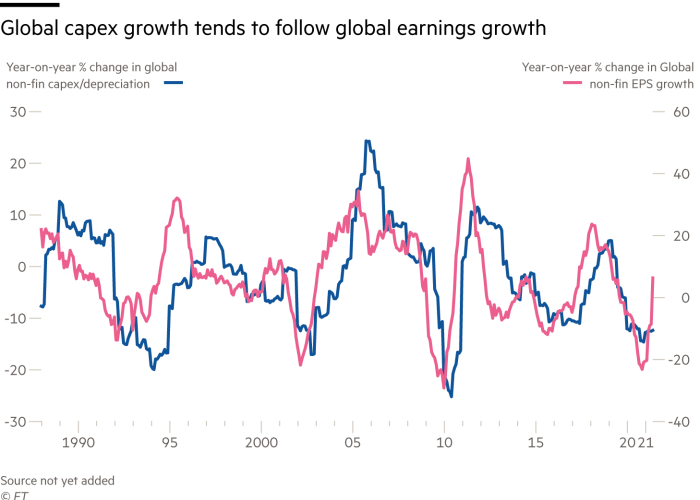The writer is co-founder and chief investment strategist at Absolute Strategy Research
The investment regime of the past two decades was dominated by capital-light business models and a focus on investing in faster-growing companies.
We see this changing, with capital-heavy models and investment in companies that are currently considered undervalued coming to the fore as short-run capacity pressures and longer run structural themes combine.
Capital-light businesses relied on globalisation and information technology not only to outsource labour, but also capital investment in areas such as machinery and equipment. Intellectual property and intangible assets became the drivers of earnings growth and market capitalisation.
“Platform companies” that connect customers and suppliers have become the ultimate expression of this information heavy/capital-light business model. Capital-heavy businesses, which have been favoured by “value” investors in the past, have floundered.
We see the policy response to the Covid-19 pandemic potentially changing the investment regime and with it the business models of the corporate sector. Monetary policy now places full employment and inclusion ahead of inflation, while fiscal policy is increasingly expansionary. US nominal GDP could increase by 10 per cent this year, while delivering the kind of mix of growth and inflation seen in the 1950s and 1960s.
The under-investment in capital-light businesses will be exposed by such rapid demand growth, resulting in increased investment as companies seek to rebuild capacity. However, these short-term pressures will only accelerate the longer-run regime shift towards capital-heavy business models.

The trend towards more capital-heavy companies is driven by four structural themes: investment in “reshoring”; a shift from investment in information to infrastructure; the need to develop climate-transition technologies and, finally, investment in technologies needed to secure geopolitical leadership. These all require shifts from investing in ideas and information to investing in stuff.
Reshoring is an investment in independence and resilience. The fragility of long, thin supply chains was exposed by both the financial crisis and Covid-19. National governments are increasingly focused on supply-chain security to ensure cyber security, biosecurity, financial security and national security.
Some companies have already recognised the potential gains. Tesla describes itself as “absurdly vertically integrated” as a way to secure rapid growth and to make copying its vehicles by buying from a catalogue of its suppliers difficult. Amazon has also invested to control its end-to-end business, with its own web service and air-cargo businesses.
Investing in infrastructure, not information, is a theme for governments, companies and investors. The Global Infrastructure Hub estimates global infrastructure needs $94tn of investment over the next 20 years to keep pace with demographics and replacing ageing infrastructure. After decades of neglect, this will boost demand for commodities and capital-heavy companies.

At the same time, climate-transition technologies will require investment in a range of areas. The broader electrification of transportation needs rapid advances in battery technology and hydrogen fuel cells. However, transportation accounts for less than a fifth of CO2 emissions, so innovations will be needed across the economy, from steel production to agriculture.
The race for geopolitical leadership is also likely to shape investment patterns. The military industrial complex was central to technological innovation and US economic growth during the 1960s, making it profitable to “piggyback” on government investments in computing and aerospace.
Today, China’s “Military Civil Fusion” programme seeks to deliver the technological advances needed to secure geopolitical leadership. Beijing’s targets range from reducing technology gaps in aviation engines and high-end semiconductors, to building leadership in quantum computing. If the US is to keep pace with China, it will need to channel capital into these areas.
Our conclusion is that the shift towards capex-heavy business models will initially be driven by those sectors that have been starved of capital over the past 20 years as they benefit from reshoring and increased infrastructure spending. However, longer term it could be the nascent technologies required for the climate transition and geopolitical “proxy wars” that deliver increased returns to investors from capital-heavy companies.
"heavy" - Google News
June 15, 2021 at 11:00AM
https://ift.tt/3wtUedW
The coming regime shift towards capital-heavy companies - Financial Times
"heavy" - Google News
https://ift.tt/35FbxvS
https://ift.tt/3c3RoCk
heavy
Bagikan Berita Ini















0 Response to "The coming regime shift towards capital-heavy companies - Financial Times"
Post a Comment